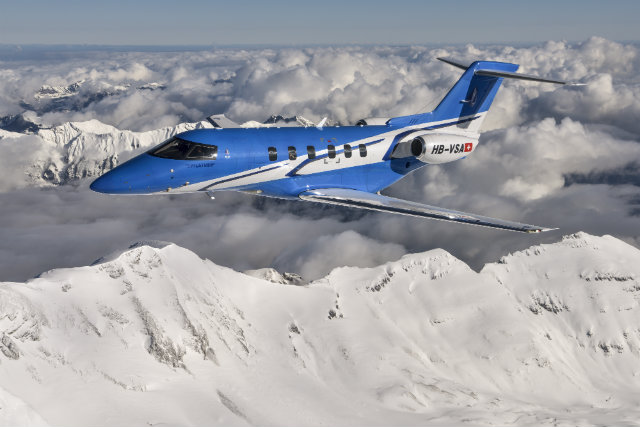Pilatus Aircraft’s hugely anticipated PC-24 business jet was awarded European and US type certification on 7 December after a 30-month flight-test campaign, which was completed on time and without incident.
The first production superlight twin, bearing the registration N124AF, will be flown in January 2018 to US fractional ownership company and long-time Pilatus customer PlaneSense, which hopes to place it into service by the end of the first quarter.
The PC-24 programme was launched to great fanfare in 2013, ushering in a new era of business jet manufacturing for the Swiss airframer, which, for more eight decades, has produced turboprop-powered aircraft from its headquarters in Stans, including the ubiquitous PC-12NG.

Pilatus Aircraft
As the best-selling single-engined turboprop for executive use, the PC-12 has given Pilatus a formidable pedigree in the business aviation market. Flight Fleets Analyzer records that the global fleet has grown to more than 1,500 examples of the 10-seat type since its introduction in 1994, including 53 units added in the first nine months of 2017.
“The Pilatus brand stands tall,” says aerospace analyst Rolland Vincent, and has won a “very loyal” owner base within the turboprop community.
The PC-12's popularity and expanding global inventory were key drivers behind the PC-24's launch. Vincent says the programme provides a “step-up path for customers delighted with the propeller aircraft, but wanting to embrace different requirements, such as longer and more demanding missions that only a jet will serve”.
Pilatus is also now able to target the brand at a wider base of potential owners and operators with larger budgets and a preference for jets rather than turboprops.
“Despite the well-proven safety and economic efficiency of single-engined operations, some organisations and individuals cannot, or simply will not, operate a single-engined turbine aircraft, whether due to company policy, insurance requirements, fear of, or aversion to, an engine-out situation, or other factors,” says Vincent. “There are some customers who simply prefer a jet, seeing it as modern technology that offers the speed they prefer.”
While the PC-24 had its formal launch in 2013, Pilatus says its has been working on the programme for over 11 years. The flight-test campaign kicked off in May 2015 and the three test aircraft have flown over 2,200h, with Pilatus taking the fleet “to the very boundaries of its limits and even beyond," it says,

Pilatus Aircraft
This rigorous testing regime has paid off, with the Williams International FJ44-4A-powered aircraft hitting or exceeding its original performance specifications. Maximum speed, for example, is now recorded at 440kt (815 km/h) - 15kt higher than predicted. The PC-24 has also met its maximum range target of over 2,000nm (3,700km) with four passengers, and 1,830nm with six.
Performance is hallmark of the PC-24’s appeal. What sets the aircraft apart from competing models in the light business jet sector, such as the Embraer Phenom 300, Bombardier Learjet 75 and Cessna Citation XLS, is its ability to take-off and land on only 856m (2,810ft) of runway, including grass and gravel strips. This feature gives the PC-24 access to over 20,000 airports around the globe, says Pilatus – more than twice as many as competing models.
Another boost to the PC-24’s multi-mission capability is its large aft cargo door. Measuring 125cm wide by 130cm tall, this feature is proving a major draw for utility, special-mission and aeromedical operators, including the Royal Flying Doctor Service (RFDS) of Australia, which has ordered six PC-24s.
The RFDS is the oldest PC-12 operator in the world, having taken delivery of its first example shortly after type certification in 1994; it operates 33 of the type today.
The PC-24's cargo door, coupled with its short take-off and landing capabilities, was behind Pilatus’s decision to give the aircraft its unique moniker – “super-versatile jet”.
Vincent says these features will “bring smiles to the many customers who will step-up from a PC-12”.
Another offering unique to the PC-24 is a “quiet power mode” which allows the FJ44 to power the aircraft’s electrical systems – including heating and air-conditioning – independent of any source of ground power, such as an auxiliary power unit.
Vincent is bullish on the PC-24’s prospects and believes the $9 million model perfectly illustrates Pilatus’s approach to aircraft development. Their “secret sauce”, he says, is clever design, precision engineering, and a philosophy that seeks to do one thing at a time, but to do it exceptionally well.
“As a relatively modestly sized OEM, and a private corporation, they are adept at channelling their available resources to take advantage of market opportunities that they seem uniquely positioned to capture.”

PlaneSense
Vincent’s optimism in the eight-passenger PC-24 is borne out by its healthy order backlog and a strong pent-up demand for the product. The first batch of 84 aircraft were sold-out within 36h of Pilatus starting to take commitments in 2014.
The airframer is expected to re-open the orderbook in late 2018, following pressure from eager customers, including PlaneSense. George Antoniadis, founder and chief executive of the Portsmouth, New Hampshire-based company has made no secret of his desire to acquire more PC-24s to add his fleet of 36 PC-12NGs – the largest commercial fleet in the world – and four Nextant 400XTi light business jets, which are being used as an interim platform for the PlaneSense jet programme.
“We were unable to buy more than six aircraft in the first round,” he says, “but I plan to place a double-digit order next time round.”
PlaneSense will take delivery of three aircraft in 2018, from total PC-24 output for the year of 23 units.
The company’s pilots will begin training in January on FlightSafety International’s recently certificated level C PC-24 simulator, based in Dallas, Texas. Following delivery, its debut aircraft will undergo proving flights with the US Federal Aviation Administration to allow it to operate under both fractional ownership and charter requirements.
Source: Flight International






















